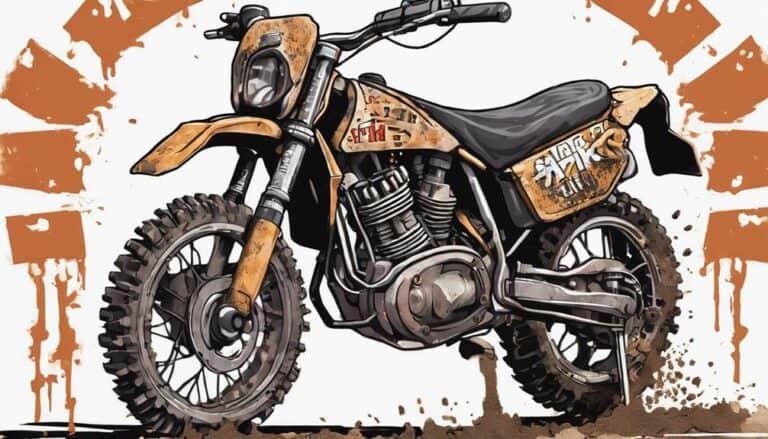If you're wondering if a bad spark plug could be causing issues with your dirt bike, look for signs like difficulty starting or rough idling.
But how can you be sure it's the spark plug? Well, the answer lies in understanding the key indicators that point to a faulty spark plug in your bike.
By grasping these important signals, you can swiftly identify and address the problem before it leads to more significant complications.
So, let's explore the telltale signs that might signal a bad spark plug in your dirt bike and how to handle the situation effectively.
Key Takeaways
- Check for symptoms like stalling, misfiring, or poor acceleration.
- Inspect spark plug condition for wear, cracks, or damage.
- Test functionality using a spark plug tester and gap measurement.
- Replace if damaged or failing to ensure optimal engine performance.
Symptoms of a Bad Spark Plug
If your dirt bike is experiencing difficulty starting or frequently stalling, it could be a sign of a bad spark plug. Ignition issues like poor acceleration, misfiring, or rough idling are common symptoms of a faulty spark plug.
When your dirt bike shows signs of decreased fuel efficiency or engine performance problems, it's essential to make sure the spark plug is in good condition. Blackened or fouled spark plug electrodes indicate the need for replacement.
To guarantee top-notch performance of your dirt bike, regular inspection and maintenance of the spark plugs are critical. By keeping an eye out for these indicators and addressing any spark plug issues promptly, you can prevent more severe problems down the line.
Checking Spark Plug Condition
When inspecting the spark plug condition on your dirt bike, be vigilant for signs of fouling, erosion, cracks, and proper spark plug gap measurement to guarantee peak performance. Here are some key points to take into account during your inspection:
- Cleaning Techniques: Use a wire brush or spark plug cleaner to remove any carbon deposits or fouling from the spark plug. This can help restore its performance and efficiency.
- Wear Indicators: Look closely at the electrode and insulator for any signs of erosion or wear. If these parts appear worn out, it may be time to replace the spark plug to maintain peak combustion.
- Visual Inspection: Examine the spark plug for any cracks or damage to the ceramic insulator. Cracks can lead to misfires and poor engine performance, so it's important to address any issues promptly.
- Proper Gap Measurement: Make sure that the spark plug gap matches the manufacturer's specifications. An incorrect gap can impact ignition timing and overall engine operation, so adjust it as needed for peak efficiency.
Testing the Spark Plug
Inspect the spark plug for physical damage such as cracks or carbon buildup to begin testing its functionality.
Spark plug diagnostics involve using a spark plug tester or performing a spark test to check if the plug is producing a spark. This test is essential for ignition system troubleshooting.
Look for signs of fouling, like black, oily, or white deposits, which can affect performance tuning. Additionally, measure the gap between the electrodes to make sure it falls within the manufacturer's specifications.
If the spark plug fails the spark test or shows visible signs of damage or wear, consider replacing it promptly to maintain peak engine performance.
Spark Plug Replacement Steps
To initiate the spark plug replacement process on your dirt bike, gather a spark plug socket and wrench for safe removal and installation. Follow these steps for a successful spark plug replacement:
- Prepare the Bike: Make sure the engine is cool before starting. Disconnect the spark plug cap to prevent accidental starts.
- Remove the Old Spark Plug: Using the spark plug socket and wrench, carefully loosen and remove the old spark plug from the engine.
- Inspect and Clean: Check the new spark plug for any signs of damage. Clean the area around the spark plug hole to prevent debris from falling into the engine.
- Install the New Spark Plug: Carefully thread the new spark plug into the engine by hand to avoid cross-threading. Once snug, use the socket and wrench to tighten it securely.
Preventing Spark Plug Issues
Regularly maintaining your spark plugs is important for preventing potential issues and ensuring the best performance in your dirt bike. To prevent spark plug issues, follow these maintenance tips.
To start, inspect your spark plugs regularly for signs of fouling or damage, such as carbon deposits or worn electrodes. Replace spark plugs according to manufacturer recommendations to prevent misfires and poor engine performance. Use a gap tool to make sure the correct spark plug gap for top ignition. Avoid over-tightening spark plugs to prevent damaging the threads in the cylinder head.
Keep the spark plug well-maintained by checking and cleaning it when necessary to make sure proper ignition and engine performance. By staying proactive with spark plug care and following these preventative measures, you can avoid common causes of spark plug issues and maintain a reliable dirt bike.
Conclusion
To sum up, remember the old adage:
'An ounce of prevention is worth a pound of cure.'
By regularly checking and replacing your spark plugs in your dirt bike, you can avoid starting issues and guarantee a smooth ride every time.
Don't wait for problems to arise – stay proactive and keep your ignition system in top shape for peak performance.

